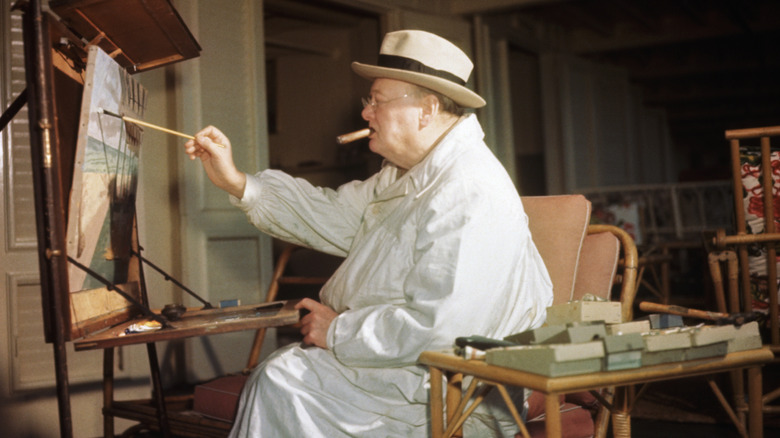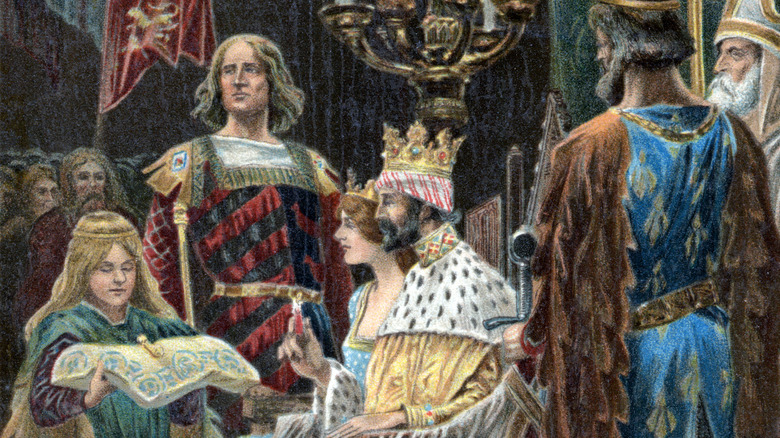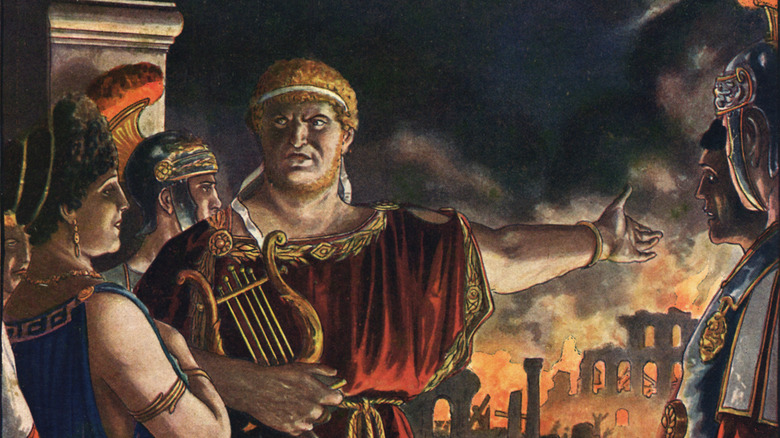The Dumbest Assassination Attempts In History
Murder isn't the noblest or kindest task that human ingenuity has been put to, but the efforts put toward killing have produced some strange methods. When it comes to assassination, the targeted murder of a prominent figure, lone actors and governments alike have spent considerable energies devising ways to do the deed. Cooking up a scheme instead of a straightforward attack might seem convoluted and demented, but the goal of such plans might be to make a death look like an accident, or to inflict humiliation on a target.
One can be horrified by the lengths such plots can go to, or have a reluctant admiration for the thought and effort put into them. But some assassination plans can seem — well, dumb. Fidel Castro may have loved good cigars, but rigging up one to explode and plotting to pass it to him at the United Nations — a real CIA scheme — is more the stuff of a Marx Brothers movie than a James Bond caper. And that's just the preamble to history's long tome of ill-conceived assassination attempts, so here are the dumbest of them all.
A poisoned squirt gun didn't take out the leader of Hamas
Khaled Mashal was a rising figure in Hamas in 1997, but not yet at the top of leadership. Nevertheless, his activities on the organization's behalf made him a prime target for assassination by Israeli prime minister Benjamin Netanyahu, who was then serving his first term in the premiership. Indeed, Netanyahu wanted Mashal targeted even before more prominent Hamas members. But the scheme that was concocted to kill Mashal left something to be desired.
The plan was to intercept Mashal while he was in Jordan. One agent would draw his attention by making a mess with a shaken can of soda, while another would approach Mashal and shoot poison into his ear with what was effectively a covert squirt gun. The poison would have acted so slowly, and dissipated so quickly, that it would never be detected. That Israeli agents had a proven track record of efficiently killing Hamas targets with snipers was completely overlooked.
Technically, the plan almost worked; Mashal was poisoned, and he came within hours of death. But the Israeli agents were caught in the act, revealing the plot. The attempted assassination on foreign soil led King Hussein of Jordan to personally demand that Netanyahu provide the antidote and release Palestinian prisoners as recompense, with no way to mitigate the international humiliation. Hussein even lobbied American officials, who made it clear Netanyahu would have to meet the king's price for his botched scheme.
Castro's poisoned cigars
Fidel Castro seemed to excite the rage and the imagination of forces within the CIA. Decades were spent plotting to depose, kill, or humiliate him, with the nature of those plots ranging wildly. The practicality and wisdom of such plans were also all over the map. An alleged attempt to smuggle an exploding cigar to Castro has achieved a degree of infamy, but it wasn't the only hare-brained plot to try and kill the dictator through one of his favorite pastimes.
According to the U.S. Senate's "Interim Report: Alleged Assassination Plots Involving Foreign Leaders," produced in 1975 (via the CIA), there was a plan in 1960 to get a box of Castro's preferred cigars, poison them, and smuggle them into his hands, where he would die as soon as one of them touched his lips. The report indicated that the CIA got a hold of the cigars in August and successfully contaminated them by October. So far, it would seem, so good. But the plot fell apart during arguably the most important phase: getting the cigars to Castro. They were handed off to an unnamed accomplice in February 1961, but the cigars weren't tracked beyond that point, and the CIA had no record of even an attempt to get the box to its intended target. A similar attempt to poison Castro's chocolate milkshake was ruined when the waiter in on the scheme accidentally broke the pill containing the toxin, spilling it before it could be mixed into the milkshake.
Castro's poisoned pen was rejected by Cuban collaborators
Some failed assassination attempts go wrong due to bad luck, and others due to poor planning. But it has to sting the egos of the minds behind such plots when they're dismissed as stupid by their own operatives. One of the CIA's many efforts to kill Fidel Castro, according to the U.S. Senate's "Interim Report: Alleged Assassination Plots Involving Foreign Leaders," involved a poison pen, but this wasn't a nasty letter so loaded with malice that Castro would die of grief. It was an actual pen fitted with a hypodermic needle, one so fine that it could be jabbed into Castro without his noticing, injecting him with a lethal dose of black leaf-40, a nicotine-based poison (via the EPA).
The pen was created at the request of a Cuban dissident, labeled in the interim report as AM/LASH. He was prepared to assassinate Castro, but wanted to find a means to do so that wouldn't risk his own life. The CIA was so heavily invested in facilitating AM/LASH's request that the report later found it likely that officers from the agency were meeting with their accomplice on the day President John F Kennedy faced his own assassination. But when AM/LASH was given the pen the CIA had made for him, he was unimpressed. "Surely [you] can come up with something more sophisticated than that," he allegedly said. The poison pen never went into use.
The Nazis wanted to kill Winston Churchill with exploding chocolate
Today, "death by chocolate" is a favorite slogan of advertisers trying to tempt customers into buying particularly rich desserts. In World War II, it was a literal scheme by the Nazis to take out their chief foe in Western Europe. British prime minister Winston Churchill liked his chocolate, and German agents thought they could use that to their advantage. Bomb makers in their employ put together small but powerful explosives hidden under a coating of dark chocolate squares. Breaking off a corner square would set off the timer, releasing a blast seven seconds later that would kill Churchill and anyone else within a few meters.
The plans for the deadly desserts apparently reached the stage where decoy branding was chosen (Peters Chocolate, in black and gold wrapping), but it fell apart soon after. Leaving aside the logistics of getting the chocolate into the hands of Churchill, British agents got wind of the scheme. Not only did this put British intelligence on the alert, but one agent was able to get a crude sketch of the chocolate bombs to Lord Victor Rothschild, head of MI5. He commissioned a public awareness campaign, with more elaborately illustrated posters alerting any potential snackers what to watch out for.
The poisoned underwear of South Africa
The apartheid regime in South Africa has enough to darken its name without delving into attempted plots against its critics. The South African Defense Force and the Roodeplaat Research Laboratories (RRL) worked to create a chemical means of assassinating or crippling various figures. At one point, there was a plan to contaminate Nelson Mandela's medication. Another scheme would have cut the fertility rates of Black women.
But if the RRL and Defense Force could sink to nefarious lows in planning ways to harm those resisting apartheid, they couldn't muster the competence to carry some of those plans out. One of their targets was the Reverend Frank Chikane. The Defense Force wanted Chikane dead, but they didn't want the assassination known as such. The solution RRL scientists devised was to poison Chikane while he was abroad in Namibia. But instead of trying to slip him the poison through meals, or surreptitiously inject him with it, the would-be assassins had an agent spread it on five pairs of Chikane's underwear.
As ludicrous as it sounds, the plan would have worked if they had picked almost any other article of clothing. The poison chosen, paraoxane, needed a sufficient dose in contact with Chikane to kill him. Shirts or pants would have done the job, but underwear covered too small an area. "It's a real mess," the RRL chief supposedly said when told of the botched job, according to David Goodman's "Fault Lines: Journeys Into the New South Africa."
Featured image by Meraj Chhaya via Wikimedia Commons | Cropped and scaled | CC BY-SA 2.0]
Louis XV's assassin couldn't pierce the king's winter clothes
Who knew that winter clothes could protect against knives, as well as frostbite? But that's exactly what happened on January 5, 1757. With Versailles drenched in snow, King Louis XV of France crossed the courtyard at 6 PM, bundled up in layers, while his guards stood nearby. Whether due to the cold, the hour, or the speed of the assailant who came out of the darkness, the guards couldn't stop the knife-wielding man who made a beeline for the king.
The attempted assassination of Louis XV could have been a watershed moment in French history had it succeeded. Instead, the king's winter layers and the killer's small blade worked together to protect him. The knife didn't even reach half an inch into the royal flesh. Voltaire, in writing about the attack, dismissed the minor wound Louis did receive as a "pinprick." Louis, understandably, didn't see it that way at the time; he went into deathbed confessions of infidelity to his queen and begged her forgiveness, before it was made clear he wasn't seriously hurt.
The attacker was a former servant, Robert-François Damiens, who likely had severe mental health issues. His ill-conceived and poorly-executed plot may have inspired dismissive contempt from Voltaire, but his public torture and execution by dismemberment brought out both revulsion and sadistic joy from spectators.
Magic couldn't kill the king of England
Magic hasn't always been just a tool for characters in high fantasy novels. Once upon a time, opponents of the king of England turned to sorcery to try and assassinate him. The king was Edward II, the year was 1324, and the magician was known as John of Nottingham. Edward II was never popular, and his reputation only soured further during his reign. According to Thomas Wright's "Narratives of Sorcery and Magic," such was the dissatisfaction with Edward by 1324 that opponents hired John to use necromancy to kill the king.
John's method involved using wax effigies of Edward and five members of his court, plus a seventh as a control. Working in an abandoned house outside Coventry, John and his apprentice, Robert Marshall, prepared the figures after the feast of St Nicholas. When the effigies were ready, John tested his control by having Marshall stab it in the head with a sharp broach. Allegedly, the man that effigy represented lost his memory the next day, and died when the broach was stabbed into the effigy's heart.
Whether John's magic had anything to do with the man's death or not, his plans for the king were foiled by his apprentice. Marshall didn't spoil things by stealing his master's hat and letting spells get out of hand, but by ratting him out. John's trial is the earliest recorded case of witchcraft in English law, but it appears the charges were dropped.
Nero's Rube Goldberg machines couldn't kill his mother
It's been questioned in recent years just how accurate the image of Nero as a debauched and irresponsible tyrant truly is. The histories that made him out to be so despicable were written after his death, drew on popular rhetorical devices at the time, and probably sought to discredit the dynasty he hailed from at the expense of later emperors. But according to those histories, a young Nero was less a hedonistic despot than he was a Roman Wile E. Coyote, employing needlessly complicated and ineffective devices to unsuccessfully kill the enemy. In Nero's case, according to Suetonius's "The Lives of the Twelve Caesars" (via the University of Chicago), that enemy was his own mother.
Per Suetonius, Nero's mother, Agrippina, was too controlling for his liking. Snubs, insults, and lawsuits served as weapons for a time, but eventually, Nero wanted his mother's head. When poisoning was ruined by her having built up immunities to every concoction he tried, Nero turned to mechanics. First, he rigged her bedroom so that the ceiling would collapse over her bed, but a co-conspirator squealed on him. Nero then applied the same scheme to a boat intended to take his mother home after the feast of Minerva. This time, the plan got as far as execution — the boat really did collapse. But Nero didn't count on one little detail: His mother could swim.








